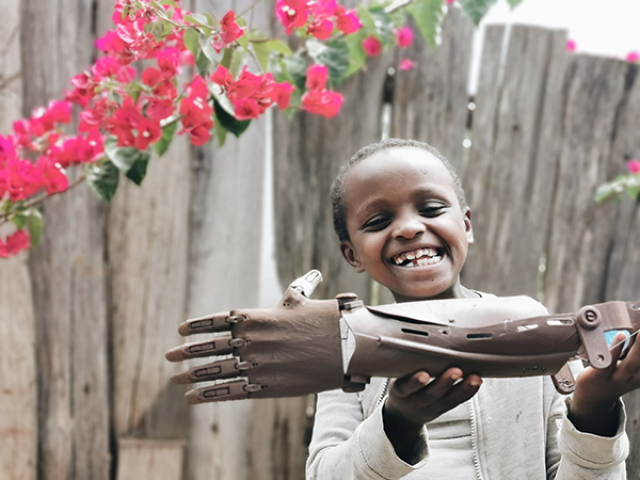Trédesis, the Ayudame3D prosthesis

Guillermo developed a passion for toys at a young age. A few years later, while working as a developer in a technology toy design company, he acquired a small 3D printer to give shape to the toys he had been inventing since childhood. It was while exploring 3D printing technical guides that he came across files on the additive manufacturing of prostheses.
From toys to 3D prostheses
As he was about to leave for a few weeks of volunteer work in an orphanage in Kenya, he had an idea: "If I can create toys, why not prostheses for the most destitute? He asked around, did some research, and took five 3D printed prosthetic arms with him. Once there, he offered them to people who had had to have one of their limbs amputated due to congenital malformations, road accidents or illnesses that were not treated in time due to local conditions.
"Helping is too easy not to do it"
Back in Madrid, he decided on his course of action: at the age of 22, he created the Ayudame3D.org association to provide "this free help to anyone who needs it". Specifically, 83 million people in the world who suffer from some form of amputation and could never have access to a device to help them in their daily lives.
Five years on, that philosophy remains unchanged: the "trédesis", or prosthetic arms, are provided and delivered free of charge to anyone who requests them. "They are and will remain free. Technology is a means to help others."
Technology in service of a social purpose
At present, Ayudame 3D consists of a team of 8 people who rely on a network of around 100 3D printing experts.
When the social enterprise receives a request for a "trédesis" through its website or social networks, it forwards it to its "3D helpers", volunteers who will design and manufacture the prostheses on their 3D printer at home according to the measurements and specifications received.
This is how Ayudame3D ends up delivering 200 to 250 prosthetic arms per year in more than 50 countries, to anyone who requests them. For regions where Internet access is more complicated, it relies on international alliances and collaborates with other associations that it trains to take the measurements for the prostheses, to deliver them, to fit them, to repair them, etc.
Recently, the NGO developed the Helping School educational programme which aims to teach primary and secondary school children how to use 3D printers and create their own "arms".
Lightweight, mouldable and sustainable plastic arms
Currently, three types of upper limb "trédesis" are manufactured: a hand prosthesis, an elbow prosthesis and a full arm prosthesis. The plastic used to make them comes from plant resources such as corn starch. PLA, or polylactic acid, is the most suitable because it weighs very little, is easily moulded (so that the prosthesis can be 100% adapted to the wearer) and is easy to use. The prostheses are made largely from reclaimed PLA coils to make the process more sustainable. In addition, defective parts are repaired and refurbished to be used in new "arms".
The prostheses manufactured by the association are not sophisticated: they are basic and the people who receive them will not be able to perform very complicated gestures. However, they will enable them to perform everyday movements, and thanks to this, to return to the world of work, to attend school and to integrate socially. These prostheses improve the quality of life of amputees and offer them new opportunities, reducing the inequalities they face.
More information:
https://ayudame3d.org





